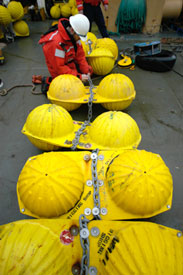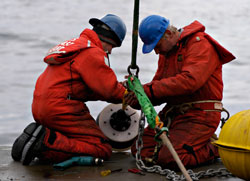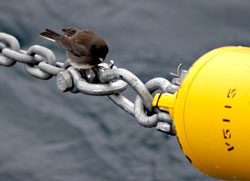 |
 |
 |
| Boatswain's mate
Darrell Bresnehan assembles the float chain on the first mooring. |
| Click
to enlarge |
Daily Update
Calendar
Dispatch 23 - October 2, 2003
By C. A. Linder
Weather conditions: Overcast skies, light rain, calm winds
and seas, air temperature 31°F
Two Down...
Less than 12 hours ago, the winds were howling around the ship,
waves crashing over the side. Today hardly a ripple broke the surface.
How can this be? Three things contribute to building large waves
- wind strength, wind duration (how long the wind has been blowing),
and wind fetch (the amount of ocean surface in contact with the
wind). Yesterday's storm certainly had the strength and duration
to build large swell waves. What it lacked was fetch. Remember that
the Arctic Ocean is mostly covered with ice. Although we are in
open water, the ice edge is not far away. Compared to a large, open
body of water like the Atlantic or the Pacific, it's like we're
sitting in a swimming pool. And that's a real great thing for our
mooring team!
This morning, the longest and most time-consuming mooring went in
the water. The way we are deploying the moorings this year is very
different from how we deployed them last year. Due to the high ice
concentration, last year the moorings were put in "anchor first."
That means exactly what it sounds like - the anchor is lowered over
the side, then instruments are attached one by one. Once the top
buoy is lowered over the side, you simply pull the release, and
off it goes, straight down to the bottom. Since we have plenty of
open water this year, the moorings will be deployed "anchor
last." For this method, the top buoy is put in first, then
the line is let out with the instruments attached. The ship steams
along at a slow pace so that the instrument chain floats behind
the ship in a line. Then, the anchor
is dropped in last, and it pulls the
instruments straight down to the bottom. This method is necessary in
open water since wave action can put a lot of tension on the mooring line during
an anchor first deployment.
 |
 |
| Ryan Schrawder (left) and John Kemp (right) attach instruments to the mooring line. |
Click
to enlarge
|
 |
| A curious junco catches a ride on the instruments as they are lowered off the fantail. |
| Click
to enlarge |
Today we deployed the two deepest moorings and one Acoustic Recording
Package. The first mooring hit the bottom only 23 meters and the
second only 11 meters from the target location. To appreciate how
amazing this is, consider that the ocean floor is roughly a mile
below us, and 23 meters is about a quarter the length of the ship!
Mrs. Cadwell's class at Varnum Brook Elementary School
has been graphing the bottom of the ocean in math, and they have
this question.
Question from Mrs. Cadwell: Do the water temps
and nutrients skim this depth or does the current mix it all in?
Answer: This is a deep question indeed, and is
actually one of the things that this multi-year project intends
to find out... What happens to the shelf waters as they move into
the deep basins. You mention the current, and that is a very important
part of the process. As the current wiggles back and forth, it occasionally
pinches off blobs of water. We call these blobs "eddies,"
and they can carry the water far out into the deep basin. We can
actually "see" this happening by looking at our CTD data.
Last year during one of our CTD sections we observed an eddy that
was filled with dirty water (from suspended sediments) moving off
of the shelf (read this dispatch from last year for more information).
This provides key evidence of how the current may be mixing the
shelf waters into the deep arctic basins. Obviously, the wonderful
data we have downloaded from the moorings will shed some light on
this issue!
This question comes from Brian, who is in the
6th grade at Wayzata West Middle School, Wayzata,
Minnesota.
Question: I would like to know the name of the worm pictured in Dispatch 18, Sept. 27th so I can research about it.
Answer: Hi Brian, thanks for writing. Believe it or not after several days we still don't know the name of that worm. We have taken numerous photos of it and Carin Ashjian will be asking her fellow biological oceanographers at the Woods Hole Oceanographic Institution when she gets back. Sorry I can't provide any more info at this time!
If our calm weather holds we will keep dropping the moorings in as
fast as we can. As we have already witnessed, this autumn arctic weather
can be quite fickle!
 Previous
Dispatch
Next Dispatch Previous
Dispatch
Next Dispatch

Back to
Calendar
|




